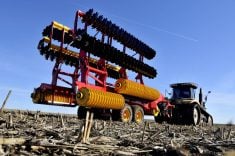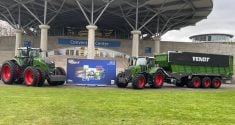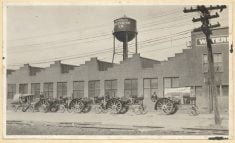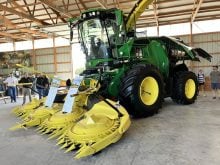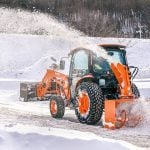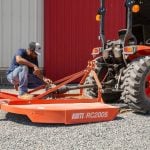Glacier FarmMedia – A Canadian company’s latest dive into haying equipment promises to vastly improve the speed of haying, while saving up to three-quarters of the fuel a producer would normally put through the tractor.
A new tool bar system from PhiBer Manufacturing of Crystal City, Man. claims to cut up to 75 per cent of fuel cost while tripling the productivity of a single tractor.
PhiBer Manufacturing’s Triple Cutter tool bar earned one of four innovations awards handed out at Ag in Motion’s digital farm show event this year.
Awards were also handed out for innovations in plant and soil, ag equipment and agribusiness services.
PhiBer Manufacturing first played with the concept of a triple cutter in 2011, according to company president Derek Friesen. That work that has now been upgraded into the company’s new line.
Built for either 16- to 18-foot New Holland HS sickle headers or 16-foot MacDon R85 disc heads, the Triple Cutter tool bar incorporates three separate headers — one mounted to the front of the tractor, two pulled from behind. Combined, the system increases the width of each pass to 48 to 54 feet.

Mechanical steering out of the centre tires allows the system to track the tractor better and minimize equipment stress, according to the company. In addition, a hydraulic cylinder in the link is designed to help producers manoeuvre hillsides, allowing the farmer to shift the system to either side.
The two pulled headers then fold up and away for transport, shrinking the profile of the tool bar to as small as 16 feet, the width of the single front-mounted header.
“We’re trying to go after productivity,” Friesen said. “The second thing is we were trying to use North American-built heads that are made for our conditions. There are other triple cutters out there that are, like, 30 feet wide, not 54, but they all have these small little cutters and conditioners.
Read Also
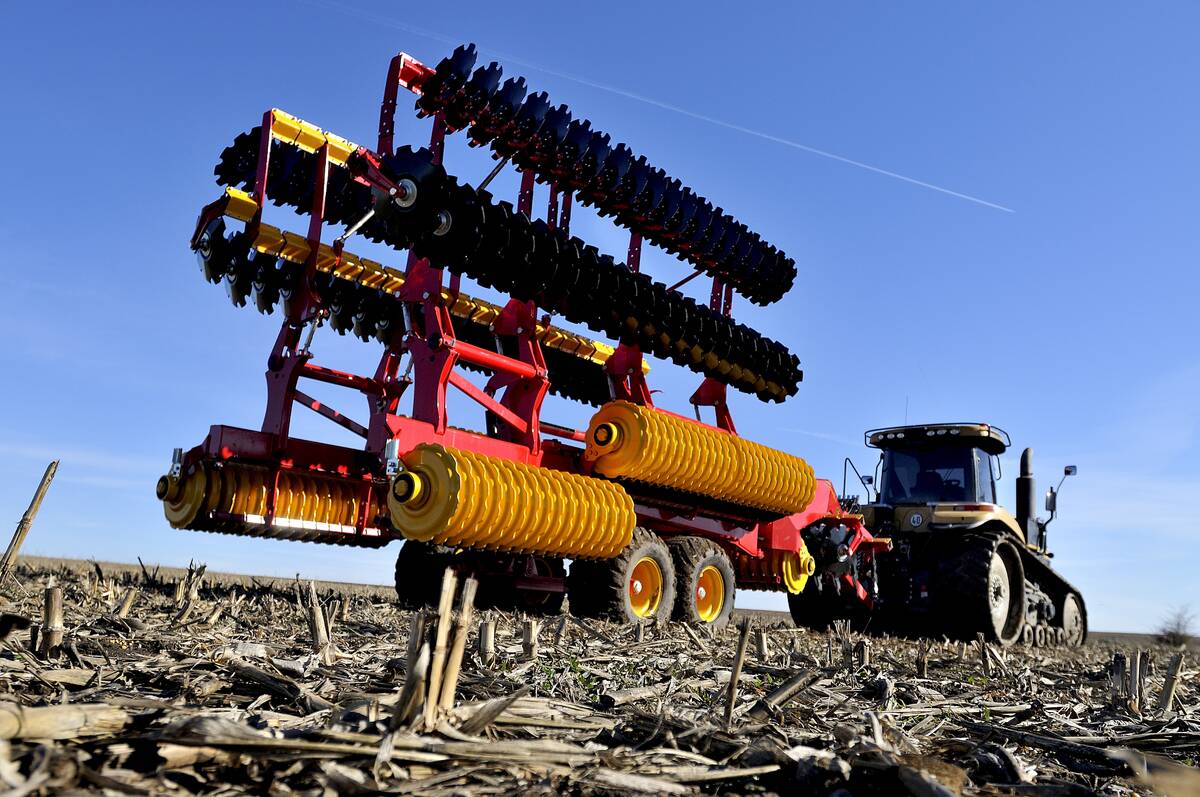
Evolution of European equipment manufacturers runs deep
A look at how Lemken and Väderstad have evolved from their traditional offerings of tillage equipment to include planting and seeding equipment in their lineups.
“The North American-built heads, we’re working with New Holland or MacDon and they’re well-built heads,” he said. “They’re rebuildable, they’re serviceable and so that’s kind of where we wanted to pursue.”
Company tests of the equipment have shown fuel savings in the range of 50 to 75 per cent.
Producers can also expect to save heavily on labour, Friesen noted. The company says producers can lay down 40 acres of hay or more per hour with the sickle system and 50-60 acres an hour with the disc system, assuming appropriate horsepower.
Friesen suggested a tractor of at least 300-330 horsepower for a producer taking up the sickle system, while the disc system would likely need 400 h.p. or more.
“Your depreciated hours are a third of what they would normally be,” he said. “So there’s some significant operating cost savings in doing this.”
Those efficiencies are one of the things that endeared the tool bar to this year’s Ag in Motion Innovations Program judges, Show Director Rob O’Connor said.
“I think what they liked about that one is how it can cut that amount of feed in one pass, but also (that it) puts it into windrows so that it can dry,” he said. “It doesn’t take that huge big cut and put it into one swath, so I think what they liked is the opportunity for it to dry down quickly.
“Otherwise, you could be wasting days trying to dry something down,” he added.
O’Connor also noted the speed in which the system would allow a producer to complete haying.

The Triple Cutter’s modular design is also deliberate to maintain manoeuvrability.
According to company materials, each header can be independently lifted, adjusted or turned from the cab. Producers can customize the angle of each head, while those with the MacDon system can also adjust disc speed from their seat.
“It does give us quite a bit of flexibility to manoeuvre,” Friesen said.
The system’s price tag will depend on configuration. Producers hitching up the sickle option can expect to pay about $200,000, according to Friesen, while those opting for MacDon can expect a slightly higher bill.
As far as Friesen is concerned, however, that cost is still significantly less than if the producer tried to capture the same gains with other kinds of new equipment.
“To buy a system like this, it’s way less money than to get that much capacity through traditional means,” he said.
While the Triple Cutter tool bar is currently limited to New Holland and MacDon, PhiBer Manufacturing says it is in discussion with other brands to potentially expand brand options.




